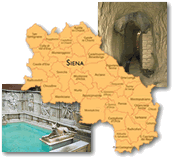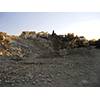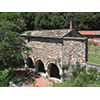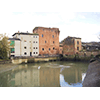Siena and Its Territory

The landscape of the Crete Senesi is the result of a centuries-old process of remodelling performed by man. Already in the frescoes of God and Bad Government by Ambrogio Lorenzetti in Palazzo Comunale of Siena, we find a depiction of the countryside fully developed by man, dominated by the rows of vineyards and vast wheat fields, which still today accompany the visitor through this territory. The survival of such a specialised agriculture necessitated an efficient irrigation system that exploited the area’s somewhat meagre water resources.
The itinerary can start out from the picturesque village of Rapolano, known since antiquity for its sulphureous springs, today exploited at modern spas.
The thermal springs of Rapolano, known since antiquity, as demonstrated by the recent discovery of a thermal complex from Roman times at Campo Muri, were analysed by many chemists and naturalists, especially under the government of the Lorraines. Among these we may recall Francesco Hoefer, Giorgio Santi and later, Antonio Targioni Tozzetti. The progress achieved by chemistry by the middle of the 18th century was to prove essential for the scientific study of thermal waters, which was conducted with the support of new theories, new methods and new instruments. Studying these waters consisted of determining the physical characteristics of the water at the spring, and evaluating its heat, odour and taste. It also consisted of chemical analysis, conducted with particular reagents to determine the water's composition and, lastly, determination of the therapeutical effects based on which each kind of water could be prescribed for specific illnesses. Still today the Baths of Rapolano attract a great number of visitors, thanks to the beneficial effects of its sulphureous-bicarbonate-calcic waters and the beauty of the surrounding countryside.
(Graziano Magrini)
Right outside town, on the provincial road of Sentino lie the vast, clearly visible travertine quarries exploited as of the 16th century for the building needs of Siena.

Located in the Sienese tract of the Ombrone valley, along the Sentino provincial road above a hill formed by extensive beds of concretionary limestone, that is to say formed by a sedimented heterogeneous material, the territory of Rapolano presents a nature formed by two qualities of sedimentary rock, varyingly extracted and utilised as building material. The western side of Mount Palazzuolo, up to the ramifications of the Ombrone valley, is formed by arenaceous secondary rocks, while the hills of the central territory of Rapolano are formed by tertiary rocks covered by beds of travertine and gravel connected by a siliceous calcareous gluten.
It was precisely the abundance of travertine, along with the presence of the renowned hydrothermal springs, that in past centuries decreed the fortunes of Rapolano. Mining activity is indeed documented since the 16th century, as shown in a document dated 1597 and concerning the Noceto quarry which was supposed to supply the material for Santa Maria in Provenzano. Principally tied to commissions contingent to the construction of single buildings, the extraction of travertine knew its moment of greatest splendour between the last years of the 19th century and the first years of the 20th century, continuing with changing fortunes up to our day.
(Anna Toscano)
To reach Siena, take SS73 for about 30 kilometres. Situated in the central Piazza del Campo, Fonte Gaia constitutes the end of a titanic work of hydraulic exploitation which traverses the entire subsoil of the city for more than 25 kilometres.
The rapid demographic growth of Siena as of the 12th century intensified the need for an efficient water supply for the population. The painstaking search for water, already testified by documents in 1176, was confronted with a system of tunnels, called "bottini", which with a network of more than 25 kilometres winds beneath the city. Built progressively between the Middle Ages and the Renaissance, this hydraulic system was capable of supplying water to the more than fifty fountains and five existing public wells, even in periods of draught.
Principally dictated by the need to guarantee water supply to one of the most water-impoverished areas of Tuscany, the work witnessed the commitment of famous Sienese engineers like Mariano di Iacopo, known as Taccola, and Francesco di Giorgio, both of whom left treatises testifying to a veritable local technological ability. These manuscript texts precisely record the techniques and instruments used to build the "bottini" system, as well as varyingly imaginative projects of hydraulic engineering: devices that could allow a man to float effortlessly in water or remain immersed at length, apparatuses to lift and draw water, projects for canalisations and river barrages.
The efficient functioning of the water system required, and continues to require, careful daily maintenance, originally entrusted to a "worker". In 1469 and 1492, this task was performed by Francesco di Giorgio himself, who was also entrusted with the project to increase the delivery of water to the fountain in Piazza del Campo (Fonte Gaia) by installing the Fonte Nuova tank there.
The visitor to Siena can admire the countless fountains, conceived as stupendous architectural structures, decorated by famous artists and, still today, supplied by the "bottini". He can also visit an underground Siena with traces of the city’s transformations, enlargements of piping, references to the districts where water arrived, and even the street numbers of houses.
(Antonella Gozzoli)
Leaving Siena on SS223 and proceeding towards Monticiano, we arrive at Bagni di Petriolo which, already in its name, testifies to its ancient vocation as a spa that has been well known and frequented since the 14th century.

Already in the 15th century, Ugolino da Montecatini, in his Tractatus de Balneis, mentioned the qualities of the water of Petriolo, suggesting at the same time rules to be followed for the treatment: "Other famous baths are those of Petriolo, rich in sulphur and composed of a very coarse substance. They greatly heat, dry, thin down and resolve the humours. They are beneficial to pains in the joints and diseases of the nerves caused by the cold. They are useful in cases of sciatica and for those who have a head full of humours. The treatment consists of keeping the bare head under the water that flows from the lion's mouth. The water must fall first on the front of the head, then on the back, without force, thus drying the humidity in the head. In these cases it usually highly beneficial, since the heating and drying effect lasts for three consecutive years."
The fame of the Baths was further enhanced by illustrious personages, such as the Pope from Pienza, Enea Silvio Piccolomini (Pius II), who visited Petriolo in June 1460, in October 1462 and in May 1464. Near the end of the 18th century the waters of Petriolo were described by the naturalist Giorgio Santi, and in the 19th century by the Sienese historian Giuseppe Giuli. Still today the baths are visited both for water treatments, especially indicated for disorders of the respiratory system and the locomoter system, and for the beauty of the landscape, which offers sights of great interest. A walk through the woods, along the river Farma, leads to a place where hot water can be seen gushing from the rocks.
(Graziano Magrini)
Alternatively, taking SR2 towards San Quirico d’Orcia, we reach Monteroni d’Arbia where, in Piazzetta del Mulino, soars the imposing mass of the fourteenth-century fortified mill with its interesting and complex hydraulic system.

The town of Monteroni d’Arbia is home to a beautiful fortified watermill, dating to the first half of the 14th century. The impressive building appears among the properties of the nearby Cuna grange, as testified by several documents of the 16th century, including one dated 1590 that bears the estimate of the rent due for a sum of 8 liras. From this and another previous document (1552), we know that the Mill worked with two millstones, though it possessed four, probably because of a decrease in flow of the waters that supplied the millrace. The fascinating hydraulic system with its round-arch conduits permitted the water to arrive inside the mill to produce hydraulic energy, and then return outside with its chemical-physical properties unchanged. Recent studies have shown that in its period of greatest activity, the Mill could produce up to half a ton of flour per day.
(Elena Fani)
From this locality, continuing southbound past San Quirico, a long detour takes us to Bagno Vignoni, through the enchanting countryside of the homonymous valley. The very heart of town consists of a large medieval thermal basin, around which the town indeed developed.
At Bagno Vignoni, an enchanting village in the Commune of San Quirico d'Orcia, there is a medieval pool of thermal water, around which stood houses, inns, and later the church of San Giovanni Battista. The numerous archaeological findings unearthed here show that the water was already utilised in Roman times. In later ages Bagno Vignoni was visited by famous personages, foremost among them Lorenzo the Magnificent and Enea Silvio Piccolomini (Pope Pius II). The water was analized and described by the naturalist Giorgio Santi, but its usefulness was not limited – as noted by Emanuele Repetti – to its therapeutic effects alone; it served, in fact, to put "in motion 5 or 6 mills built one above another inside the travertine caves."
Today, thanks to rearrangement of the area carried out by the Commune and the ensuing inauguration of the "Park of the Mills", visitors can admire some of the buildings mentioned by Repetti, which remained abandoned up to the middle of the 1950s. The activity of milling was, in fact, along with that of the baths, one of Bagno Vignoni's major resources.
(Graziano Magrini)
****************************
Texts by Elena Fani
English translation by Victor Beard
Last update 29/gen/2008



 = libraries and archives
= libraries and archives  = scientific research centers
= scientific research centers  = memorial places of scientists
= memorial places of scientists = public health places
= public health places = places of science and worship
= places of science and worship = places of technology
= places of technology  = museums and collections
= museums and collections  = villas and gardens of science
= villas and gardens of science

